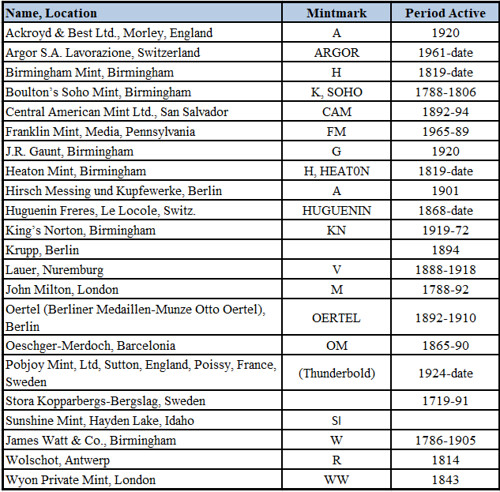
PREV ARTICLE
NEXT ARTICLE
FULL ISSUE
PREV FULL ISSUE
VOCABULARY TERMS: NATIONAL, BRANCH, PRIVATE MINTSDick Johnson submitted these entries from his Encyclopedia of Coin and Medal Terminology. Thanks. -Editor
National Mint. A government mint; the factory that produces coins for the country in which it is located. Forty-nine countries at the end of the 20th century have
national mints; others have their coins struck by custom minting either at other national mints or by a PRIVATE MINT. Branch Mint. A subsidiary mint in countries with more than one national mint. Branch mints are more concerned with production of struck pieces and may not have the capability of engraving and die production. In the United States, the Philadelphia Mint prepares dies for all branch mints (until 1994 when some dies were made at the Denver Mint) – including San Francisco, West Point, and formerly in New Orleans, Carson City, Dahlonaga Georgia. The Royal Canadian Mint, was established in Ottawa, Ontario in 1908 as a branch of England’s Royal Mint; it became a Canadian Crown Corporation 1960. It now has branch mints in Hull, Quebec (since 1965 for numismatic products), and Winnipeg (since 1975 for high production coinage). Other countries that have branch mints include France, Germany, India, Japan in addition to the United States and Canada. The first branch mints were established by Isaac Newton (1642-1727) in England, after he was made warden of the London Mint in 1696. He oversaw the establishment of branch mints in Bristol, Chester, Exeter, Norwich and York. Dies would be made at the Royal Mint in London, shipped to these branch mints and coins struck there. Branch mints are established, in any country from the 17th century through the 20th century, for the same reasons: to meet local demand for coin, and to reduce costs of transporting bullion or
struck coin. References: CH54 {1983} HAXBY. Private Mint. A nongovernment mint. A private manufacturer with blanking, coining and die-making equipment to custom produce coins, tokens and small medals for anyone. Private mints have been established in countries of high industrial activity: Great Britain, Germany, Belgium, Spain, Sweden, Switzerland, and the United States. The term “mint” in the term implies the manufacture of coins, requiring the use of coining presses. But these same coining presses can also strike tokens – and medals like coins (see COIN-MEDAL). To keep their presses busy, private mints frequently strike noncoin items. However, coining presses cannot strike pieces larger than, say, two inches; thus private mints generally do not have the capacity for large medal manufacturing. This is the specialize activity of medal makers (see MEDAL MANUFACTURING). Private mints have never replaced national mints (governments closely guard this exclusive right to strike their own coins). However private mints have rendered services, like supplying roll strip or blanks, to national mints in times of need. Only in the 20th century have private mints taken on a marketing activity to sell direct to the public the coins, medals and tokens they produce. History of private mints. The first such private mint was Matthew Boulton’s Soho Mint in Birmingham, established in 1788. In the 1760s Boulton developed an engine business based upon the inventions of James Watt. Once this business was running smoothly Boulton sought other ventures involving machinery that could run off his steam powered engines. He made experiments with die stamping, establishing, in 1782, a shop for diestamping and a button factory. He struck some prototype coins as early as 1786. There was a shortage of copper coinage in England at the time and Boulton developed a plan for striking coins to relieve the shortage. To implement this plan he established the Soho Mint. He hired Jean-Pierre Droz (1746-1823), a Swiss engraver working at the Paris Mint, built a building and filled it with machinery run by his engines. He didn’t get the contract to strike coins for the sovereignty, but he did strike coins for countries (Bahamas) and tokens for the merchants of England. In 1805 this early effort failed but some of the equipment was obtained by the son of his old partner, James Watt, who had established a mint under this name. And some was obtained by Ralph Heaton, who, in 1819 established the Heaton Mint. The later flourished and has been called The Birmingham Mint, or simply, The Mint, ever since. While the Birmingham Mint dominated private custom coining for a century, some German firms were very active. Berlin’s Oertel not only struck coins, but medals of all sizes, and tokens as well. Here are some notable private mints and their marks:  CLASS 12.2 References:: Looking for the meaning of a numismatic word, or the description of a term? Try the Newman Numismatic Portal's Numismatic Dictionary at: https://nnp.wustl.edu/library/dictionary Or if you would like a printed copy of the complete Encyclopedia, it is available. There are 1,854 terms, on 678 pages, in The Encyclopedia of Coin and Medal Technology. Even running two a week would require more than 19 years to publish them all. If you would like an advance draft of this vital reference work it may be obtained from the author for your check of $50 sent postpaid. Dick Johnson, 139 Thompson Drive, Torrington, CT 06790. Wayne Homren, Editor The Numismatic Bibliomania Society is a non-profit organization promoting numismatic literature. See our web site at coinbooks.org. To submit items for publication in The E-Sylum, write to the Editor at this address: whomren@gmail.com To subscribe go to: https://my.binhost.com/lists/listinfo/esylum All Rights Reserved. NBS Home Page Contact the NBS webmaster 
|